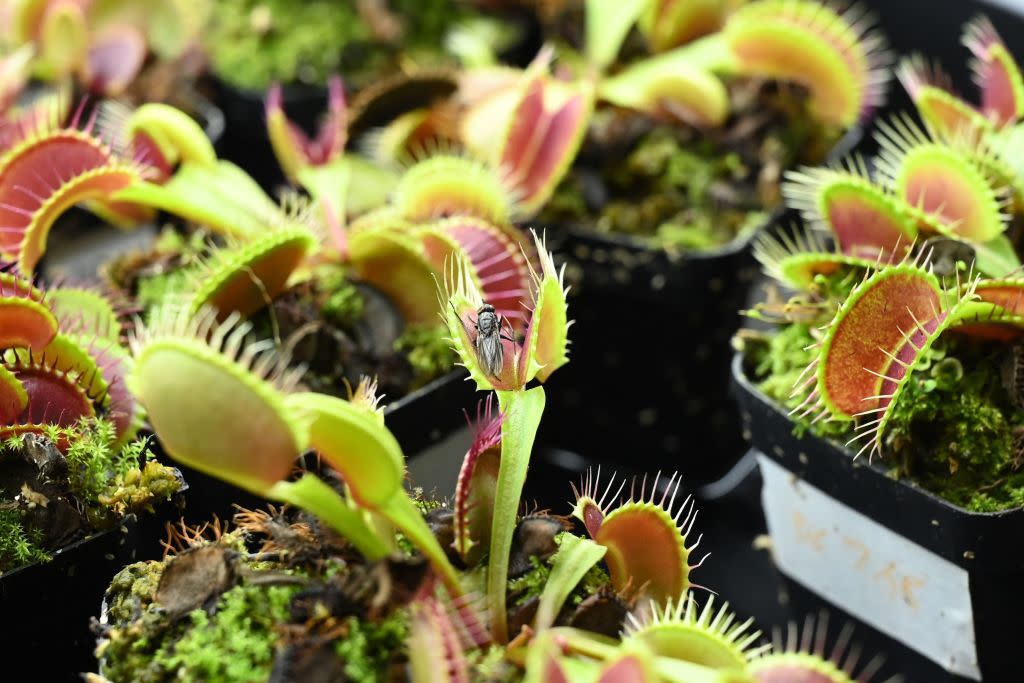How to Successfully Grow a Venus Flytrap From Seed

ROSLYN ROHMAN / Getty Images
Carniverous plants like the Venus flytrap are unique on their own, but did you know you can give your own a little something extra by growing it from seed?
Like all perennials, Venus flytrap (Dionaea muscipula) produces flowers and seeds which can be propagated and grown into new Venus flytrap plants. You can grow this unusual carnivorous plant from purchased seeds or from seeds gathered from your own plants or those of a gardening buddy.
Here's our step-by-step guide to growing a Venus flytrap from seed. It'll be eating in no time.
How to Grow Your Own Venus Flytrap
The ideal time for starting Venus flytrap seeds is late June or early July. Seeds should be sown as soon as they are available. They do not require a cold stratification period and, although germination rates remain good for up to a year when seeds are kept refrigerated, your chances of success improve when seed is planted as soon as you receive it. Gather together these supplies and follow the steps below:
Sphagnum or peat moss
Silica sand
Small perlite
Distilled water or rainwater
A plastic container with a lid, a terrarium, or seed starting tray, and plastic wrap or covering
1. Mix the Germination Medium
A soilless mix is the best option for germinating seeds. Combine approximately one part sphagnum or peat moss with one part silica sand. Mix in a handful of perlite.
2. Fill the Germination Container With Moistened Medium
Fill seed starting containers to within about an inch of the top with moistened germination mix.
Seeds need heat, light, and humidity to germinate but they also need ventilation and air circulation. You can use a plastic lid or covering, but it needs to have holes in it for air circulation. A glass dome or something that doesn't allow for air circulation won't work.
3. Scatter Seeds on Top of the Medium
Scatter Venus flytrap seeds on top of the germination mix. Do not press them into the mix or bury them. Use a strainer to sift a fine dusting of sphagnum moss over the seeds. Cover the seeds only enough that you can still see them through the moss.
4. Spray the Seeds
Moisten the sown seeds by lightly spraying them, ideally with distilled water or rainwater.
5. Cover the Container and Keep Seeds Moist
Cover the container with the ventilated top but remove the cover at least once every day and fan the air above the seeds to improve air circulation and release built-up heat. Continue to spray seeds once or twice daily to keep them moist at all times. If the container has drainage holes, it can be set in a second container filled with several inches of water for bottom watering.
6. Provide Ideal Growing Conditions
Venus flytrap seeds germinate best in temperatures between 78°F and 90°F. They should begin to sprout in 13 to 15 days. Seeds will germinate at lower temperatures but may take as long as five weeks. Give them as much bright, indirect light as possible, ideally 13 hours daily. Supplement with grow lights.
7. When Most Seeds Have Sprouted Remove Top Covers
Remove top covers when most of the seeds have sprouted the first two seed leaves. Move containers to a location that receives more direct sunlight, 3 to 4 hours daily. Watering frequency can be reduced, but continue to keep the seedlings consistently moist.
8. Transplant When the First Small Trap Begins to Form
When seed leaves have opened to their full length and the first small trap begins to form, it's time to transplant the seedlings. Use combinations of moss, sand, perlite and soil. Avoid any potting mix with fertilizers.
Your tiny new plant will have a small delicate root. Use a small knife, spoon, or even a toothpick to gently lift the plant with attached root out of the growing medium. Make a small hole in the plant's new pot and carefully place the root into the hole. Cover it with potting mix and use your fingers to gently press the plant into an upright position. Place new plants in a location that gets plenty of bright, indirect light daily and water when potting medium dries out by 25%.
Venus Flytrap Care
Venus flytrap can be grown as a houseplant but thrives best in outdoor conditions. Give plants plenty of sunlight with at least 4 hours of bright, direct sunlight daily. Native to boggy, swampy environments, these plants should be kept consistently moist.
Chemicals found in tap water can damage and kill Venus flytrap so use distilled water, rainwater or water collected from a humidifier or air conditioner for irrigating.
Venus flytrap grows in nutritionally poor soil and has adapted its carnivorous behavior, capturing and consuming insects as fertilizer to supplement nutritional needs. Grown outdoors, plants are able to feed themselves and can go for several months without consuming prey. You may need to supplement plants grown indoors by feeding live insects. Venus flytraps consume insects including ants, grasshoppers, flying insects, beetles and spiders, which can be purchased online or in some garden stores.
Frequently Asked Questions
How long does it take to grow a Venus flytrap plant from seed?
Though Venus flytrap seeds germinate in about two weeks, it can take several several weeks of growth before it's ready to be transplanted.
Do you need to soak Venus flytrap seeds before planting them?
Venus flytrap seeds do not need to be soaked or cold stratified before planting. They should be sown immediately or sealed in a bag and kept refrigerated. Once placed on top of the germination medium, seeds must be kept consistently moist.
How long does it take for a Venus flytrap to reach maturity?
It takes from three to five years to grow a mature Venus flytrap from seed.
13 Pretty Carnivorous Plants That Eat Bugs
Read the original article on The Spruce.

